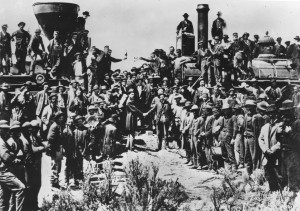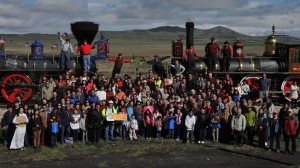On May 9th, history was made as the Chinese Railroad Workers were inducted into the U.S. Labor Hall of Honor. You can view the entire ceremony on the Department of Labor’s YouTube channel. If you don’t happen to know:
“But too often lost in discussions of this awe-inspiring achievement is the contribution of the approximately 12,000 Chinese laborers who took on the grueling task of completing the western section of the track. It was backbreaking, dangerous work. Many of these workers died from the harsh winters and brutal conditions. They laid tracks on terrain that rose 7,000 feet in less than 100 miles, chipped away at the granite and planted explosives that were used to blast tunnels through the treacherous Sierra Nevada Mountains.”
the first transcontinental railroad was built with the help of Chinese laborers, which has often been forgotten and erased from history at Promontory Point , as I had blogged about previously.
However, if you are just into the highlights, The Chinese Historical Society of America documented the ceremony with excerpts from the speeches given by Deputy Secretary of Labor Christoper Lu, Secretary of Labor Thomas Perez and Chinese Railroad worker descendant Connie Young Yu.
Related to the honoring of the Department of Labor’s Hall of Honor honor for the Chinese railroad workers, the most famous photo related to the completion of the transcontinental railaord was taken with both the Eastern and Western section of the rail track were joined, at what is now known as Promontory Point, in Promontory Summit, Utah. However, no Chinese laborers were included in that famous photo:
“Over the years, one photograph in particular from May 10, 1869, has taken root in U.S. history. “It’s a black-and-white, very historic-looking photo,” says Connie Young Yu, the great-granddaughter of a Chinese laborer on the railroad. The iconic image shows a crowd of men swarmed around two locomotives “In the middle are the two engineers shaking hands,” Yu says. “And above them are workers hoisting champagne bottles.” … But the portrait wasn’t perfect. “History — at least photographically — says that the Chinese were not present,” says photographer Corky Lee. As a junior high school student, he pored over the photo with a magnifying glass. But he couldn’t spot a single Chinese laborer in the picture, even though more than 12,000 workers from southern China were hired by the Central Pacific Railroad. They made up the overwhelming majority of its workforce.”
So on the 145th anniversary of the famous photo, that photo was re-enacted:
“So, in 2002, Lee gathered a group of Chinese-Americans at that same location in northern Utah to re-create the historic shot, and he did it again on Saturday [May 10th] with some descendants of those Chinese laborers. “They’re standing in the same spot where, 145 years ago, there were no Chinese,” he says. Ze Min Xiao, a board member of the Utah chapter of OCA – Asian Pacific American Advocates, helped to organize the event. She doesn’t have ancestors who worked on the transcontinental railroad, but for her, it’s still a period of American history worth remembering.”
The Salt Lake City Tribune also has a nice account of the reenactment. It’s nice to see that the Department of Labor is officially honoring the Chinese railroad workers and recognizing their contribution to one of the crowning infrastructure achievements in American history and seeing private individuals also honoring an iconic photograph with a more complete representation of those who helped make the completion of the first transcontinental railroad possible.
- Excited
- Fascinated
- Amused
- Disgusted
- Sad
- Angry










